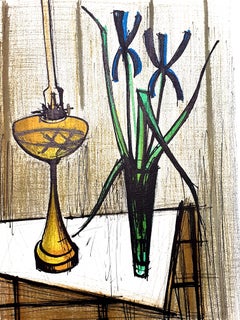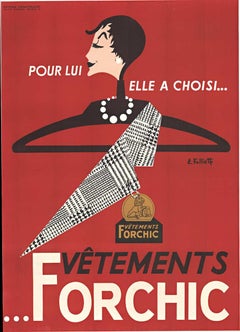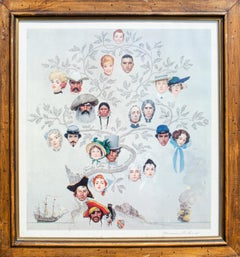Charles Sorlier Art
to
1
Overall Width
to
Overall Height
to
1
1
1
1
1
1
1
1
8,244
2,807
1,643
1,319
1
Artist: Charles Sorlier
Bernard Buffet - Iris Still Life - Original Lithograph
By Charles Sorlier
Located in Collonge Bellerive, Geneve, CH
Bernard Buffet - Iris Still Life - Original Lithograph
Dimensions: 32 x 24 cm
Edition : 6000
Paris, Michèle Trinckvel, Draeger, 1979,
Unsigned and unumbered as issued
Category
1970s Modern Charles Sorlier Art
Materials
Lithograph
Related Items
Original Vetements Forchic French fashion vintage poster
Located in Spokane, WA
Original lithograph, linen backed. Vetements Forchic. Pour Lui; Elle a Choise. Archival linen-backed vintage French fashion poster in fine...
Category
1940s American Modern Charles Sorlier Art
Materials
Lithograph
$1,000 Sale Price
20% Off
H 61 in W 44.25 in D 0.05 in
Norman Rockwell "Family Tree" Lithograph
By Norman Rockwell
Located in New York, NY
Norman Rockwell (American, 1894-1978)
Family Tree
Original painting produced 1959, this print published 1959 in Japan by The Curtis Publishing Company
Lithograph
Sight: 19 1/4 x 13 3...
Category
1920s American Modern Charles Sorlier Art
Materials
Lithograph
Vintage SIGNED Kitaj Poster, La Fabbrica, Milan (A Life 1975) woman in red dress
By Ronald Brooks Kitaj
Located in New York, NY
Printed in 1975, this poster features the encounter between an alluring woman dressed in red, and a man with his back to the viewer. The light of a streetlamp is beautifully imitated...
Category
Late 20th Century Modern Charles Sorlier Art
Materials
Lithograph
Original Pin-Up - Telephone Call linen backed vintage pinup girl.
Located in Spokane, WA
Behold the original lithographic Petty Pin-up, a unique vertical-format piece. The see-through bathing suit she wears seems to make her glow, especially with her red hair peeking fro...
Category
1940s American Modern Charles Sorlier Art
Materials
Lithograph
$598
H 19 in W 12.25 in D 0.05 in
Alicia Wiencek Fiene, Jewish Student
By Alicia Wiencek Fiene
Located in New York, NY
Work by Alicia Wiencek (Mrs. Edward Fiene) is generally extremely scarce. This print comes up from time to time and was made an actual edition (of 8) at a time when many artists didn...
Category
1930s American Modern Charles Sorlier Art
Materials
Lithograph
Topol in Fiddler on the Roof (Hand signed by Chaim Topol and the original cast)
Located in New York, NY
Chaim Topol in Fiddler on the Roof (Hand signed by Chaim Topol and the original cast members), 1990
Offset lithograph poster (ink signed)
Hand signed in ink by Chaim Topol, Marcia Le...
Category
1990s Modern Charles Sorlier Art
Materials
Ink, Lithograph, Offset
$500
H 22 in W 14.5 in D 0.5 in
Original Quand le Rire Etait Roi Original Vintage French Poster, linen backed
By Boris Grinsson
Located in Spokane, WA
Original poster: QUAND LE RIRE ETAIT ROI. ( When Laughter Was King.) Artist: Boris Grinsson. French smaller format vintage movie comedy printed in 1960. Archival linen backed ...
Category
1960s American Modern Charles Sorlier Art
Materials
Lithograph
$595
H 27.5 in W 20 in D 0.05 in
Sunday Afternoon
By Lucille Fink
Located in New York, NY
Lucille Fink creates slightly bizarre, densely drawn spaces. Signed, titled, and numbered '19,' in pencil. Annotated on the reverse, "June, 1932, week of 6-10-32, last wk of school."...
Category
Early 20th Century American Modern Charles Sorlier Art
Materials
Lithograph
Lucille Fink, Girl with Flowers
By Lucille Fink
Located in New York, NY
Lucille Fink creates densely drawn compositions, often a little off-beat. Signed and titled. Dated on the reverse.
Category
Early 20th Century American Modern Charles Sorlier Art
Materials
Lithograph
L'efant aux biscuit (Child with Cookie)
By Pierre-Auguste Renoir
Located in Palo Alto, CA
An intimate portrait of his second son, Jean Renoir (1894 – 1979), evokes a childlike sentiment and love that Renoir had for his children. Most likely no more than age 3, Jean is shown here with a cookie, beneath a frilly bonnet characteristic of late 19th century French society. His pink, rosy cheeks are defined with rich, glowing hues that contrast from the pale yellow and grey background in which he rests. Jean was also featured in a family portrait of the Renoirs, titled La Famille de l’Artiste (1896).
Created in 1899, this Color Lithograph on Cream Laid Paper is from the edition of 100, from the unpublishedL’Album d’estampes originales de la Galerie Vollard; printed by Auguste Clot, Paris.
Catalogue Raisonné:
It is fully documented and referenced in the below catalogue raisonnés and texts (copies will be enclosed as added documentation with the invoices that will accompany the final sale of the work):
1. Delteil, Loys. Pierre-Auguste Renoir, l’œuvre grave...
Category
1890s Modern Charles Sorlier Art
Materials
Lithograph
$12,300 Sale Price
40% Off
H 35 in W 39 in
Joseph Hirsch, Beard
By Joseph Hirsch
Located in New York, NY
Joseph Hirsch had such empathy for his subjects! But he was also an amazingly skilled lithographer who could get extremely delicate details out of the stone. Signed and numbered in p...
Category
Mid-20th Century American Modern Charles Sorlier Art
Materials
Lithograph
Couverture Mourlot IV
By Pablo Picasso
Located in Wien, 9
Pablo Picasso (1881-1973)
Couverture Mourlot IV is the original book cover of the monograph "Picasso. Lithograph". It consist of spine, front and back. Edition 3000, cat. raisonné M...
Category
1960s Modern Charles Sorlier Art
Materials
Lithograph
Charles Sorlier art for sale on 1stDibs.
Find a wide variety of authentic Charles Sorlier art available for sale on 1stDibs. You can also browse by medium to find art by Charles Sorlier in lithograph and more. Much of the original work by this artist or collective was created during the 1970s and is mostly associated with the modern style. Not every interior allows for large Charles Sorlier art, so small editions measuring 10 inches across are available. Customers who are interested in this artist might also find the work of Knox Martin, Virgilio Guidi, and Fritz Eichenberg.. Charles Sorlier art prices can differ depending upon medium, time period and other attributes. On 1stDibs, the price for these items starts at $1,114 and tops out at $1,114, while the average work can sell for $1,114.


